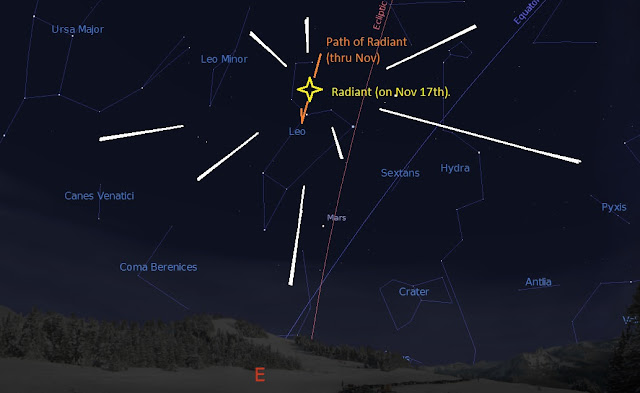Taurids Meteor Shower
On the night of November 5, the Taurids Meteor Shower will peak, and with an early setting moon, there should be desirable dark skies for viewing. Look near the constellation Taurus, but be aware that meteors can appear anywhere in the sky.
 |
| Radiant of the Leonid Meteor Shower - Illustration by Universe Today. |
Leonid Meteor Shower
Bundle up and get outside after midnight on November 17th to see the peak of the Leonids meteor shower as "shooting stars" appear to radiate outwards from the constellation Leo. The waxing gibbous Moon will set shortly after midnight, so the best time for meteor-gazing will be in the wee hours of November 18th when the skies will be nice and dark.
 |
| M45 - The Pleiades (the Seven Sisters) - Image by Insight Observatory. |
The Pleiades
November is sometimes called "The month of the Pleiades," since the star cluster is visible all night long for observers in the Northern hemisphere. From a dark sky site, M45 is easy to see with the unaided eye and resembles a small "teaspoon" pattern in the sky. Use astronomy binoculars for immersive views of this open star cluster, or use a telescope with a lower-power eyepiece for a closer look at the Seven Sisters.
Mercury
The next night, November 6, will be the best time to observe the smallest and innermost planet in the Solar System as it will be at its greatest eastern elongation. It'll be low in the western sky shortly after sunset.
New Moon
This is the best time of the month to observe the fainter deep-sky objects such as galaxies and star clusters because there is no moonlight to interfere.
Double Cluster in Perseus
Use a pair of big binoculars or a shorter focal length telescope with a wide-field eyepiece in November to seek out the sparkling Double Cluster in Perseus - two side-by-side open star clusters NGC 884 and NGC 869.
All objects described above can easily be seen with the suggested equipment from a dark sky site, a viewing location some distance away from city lights where light pollution and when bright moonlight does not overpower the stars.

No comments:
Post a Comment